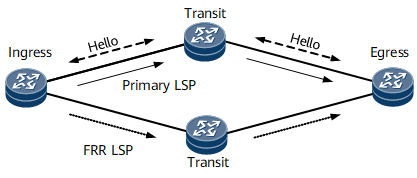BFD for LDP LSP
Bidirectional forwarding detection (BFD) monitors Label Distribution Protocol (LDP) label switched paths (LSPs). If an LDP LSP fails, BFD can rapidly detect the fault and trigger a primary/backup LSP switchover, which improves network reliability.
Background
If a node or link along an LDP LSP that is transmitting traffic fails, traffic switches to a backup LSP. The path switchover speed depends on the detection duration and traffic switchover duration. A delayed path switchover causes traffic loss. LDP fast reroute (FRR) can be used to speed up the traffic switchover, but not the detection process.
The rapid, light-load BFD mechanism is used to quickly detect faults and trigger a primary/backup LSP switchover, which minimizes data loss and improves service reliability.
BFD for LDP LSP
BFD for LDP LSP is implemented by establishing a BFD session between two nodes on both ends of an LSP and binding the session to the LSP. BFD rapidly detects LSP faults and triggers a traffic switchover. When BFD monitors a unidirectional LDP LSP, the reverse path of the LDP LSP can be an IP link, an LDP LSP, or a traffic engineering (TE) tunnel.
- Static configuration: The negotiation of a BFD session is performed using the local and remote discriminators that are manually configured for the BFD session to be established. On a local LSR, you can bind an LSP with a specified next-hop IP address to a BFD session with a specified peer IP address.
- Dynamic establishment: The negotiation of a BFD session is performed using the BFD discriminator type-length-value (TLV) in an LSP ping packet. You must specify a policy for establishing BFD sessions on a local LSR. The LSR automatically establishes BFD sessions with its peers and binds the BFD sessions to LSPs using either of the following policies:
- Host address-based policy: The local LSR uses all host addresses to establish BFD sessions. You can specify a next-hop IP address and an outbound interface name of LSPs and establish BFD sessions to monitor the specified LSPs.
- Forwarding equivalence class (FEC)-based policy: The local LSR uses host addresses listed in a configured FEC list to automatically establish BFD sessions.

Although BFD for LDP is enabled on a proxy egress, a BFD session cannot be established for the reverse path of a proxy egress LSP on the proxy egress.
BFD for LDP Tunnel
BFD for LDP LSP only detects primary LSP faults and switches traffic to an FRR bypass LSP or existing load-balancing LSPs. If the primary and FRR bypass LSPs or the primary and load-balancing LSPs fail simultaneously, the BFD mechanism does not take effect. LDP can instruct its upper-layer application to perform a protection switchover (such as VPN FRR or VPN equal-cost load balancing) only after LDP itself detects the FRR bypass LSP failure or the load-balancing LSP failure.
To address this issue, BFD for LDP tunnel is used. LDP tunnels include the primary LSP and FRR bypass LSP. The BFD for LDP tunnel mechanism establishes a BFD session that can simultaneously monitor the primary and FRR bypass LSPs or the primary and load-balancing LSPs. If both the primary and FRR bypass LSPs fail or both the primary and load-balancing LSPs fail, BFD rapidly detects the failures and instructs the LDP upper-layer application to perform a protection switchover, which minimizes traffic loss.
BFD for LDP tunnel uses the same mechanism as BFD for LDP LSP to monitor the connectivity of each LSP in an LDP tunnel. Unlike BFD for LDP LSP, BFD for LDP tunnel has the following characteristics:
Usage Scenarios
- BFD for LDP LSP can be used when primary and bypass LDP FRR LSPs are established.
- BFD for LDP Tunnel can be used when primary and bypass virtual private network (VPN) FRR LSPs are established.
Benefits
BFD for LDP LSP provides a rapid, light-load fault detection mechanism for LDP LSPs, which improves network reliability.
